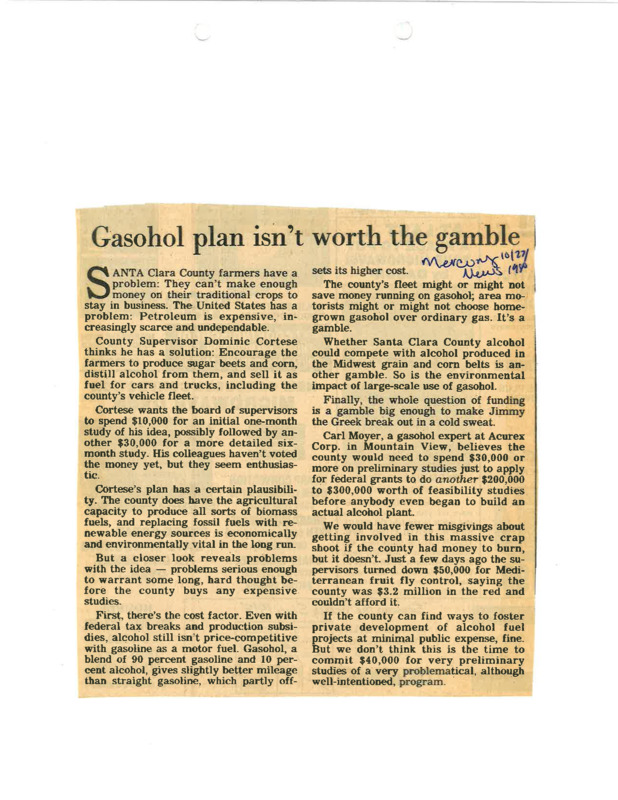A piece of a newspaper regarding the article of "Gasohol plan isn't worth the gamble"
Gasohol plan isn't worth the gamble
C{ enfa Clara County farmers have a
.\,
problem: They cafirt make enough
L/money od their traditional erops to
stay in business. The United States has a
problem: Petroleum is expensive, increasingly scarce and undependable.
County Supervisor Dominic Cortese
thinks he has a solution: Encourage the
farmers to produee stgar beets and corn,
distill alcohol from them, and sell it as
fuel for cars and trucks, including the
county's vehicle fleet.
Cortese wants the board of supervisors
to spend $10,000 for an initial one-month
study of his idea, possibly followed by another $30,000 for a more detailed sixmonth study. His colleagues haven't voted
the money yet, but they seem enthusiastic.
Cortese's plan has a certain plausibility. The county does have the agricultural
capacity to produce all sorts of biomass
fuels, and replacing fossil fuels with re.
newable energy sources is,economically
and environmentally vital in the long run.
But a closer look reveals problems
with the idea - problems serioirs enough
to warrant some long, hard thought before the county buys any expensive
studies.
First, there's the cost faetor. Even with
federal tax breaks and production subsidies, alcohol still isn't priee-competitive
with gasoline as a motor fuel. Gasohol, a
blend of 90 percrent gasoline and 10 percent alcohol, gives slightly better mileage
than straight gasoline, which partly off-
sets its higher
cost.
"'&t65tit;/
The county's fleet might or might not
save money running on gasohol; area mt>
torists might or might not choose homegrown gasohol over ordinary gas. It's a
gamble.
Whether Santa Clara County alcohol
could compete with alcohol produced in
the Midwest grain and corn belts is another gamble. So is the environmental
impact of large'scale use of gasohol.
Finally, the whole question of funding
is a gambte big enough to make Jimmy
the Greek break out in a cold sweat.
Carl Moyer, a gasoliol expert at Acurex
Corp- in Mountain View, believes the
county would need to spend 930,000 or
more on preliminary studies just to apply
for federal grants tado another gZ0Q000
to $300,000 worth of feasibility studies
before anybody even began to build an
aetual aleohol plantI[re would have fewer misgivings about
getting involved in this massive crap
shoot if the county had money to burn,
but it doesn't. Just a few days ago the supervisors turned down $50,000 for Mediterranean fruit fly control, saying the
county was $3.2 million in the red and
couldn't afford it.
If the county can find ways to foster
private development of alcohol fuel
projects at minimal public expense, fineBut we don't think this is the time to
comqrit $40,000 for very preliminary
studies of a very problematical, alttrough
well-intentioned, program.
C{ enfa Clara County farmers have a
.\,
problem: They cafirt make enough
L/money od their traditional erops to
stay in business. The United States has a
problem: Petroleum is expensive, increasingly scarce and undependable.
County Supervisor Dominic Cortese
thinks he has a solution: Encourage the
farmers to produee stgar beets and corn,
distill alcohol from them, and sell it as
fuel for cars and trucks, including the
county's vehicle fleet.
Cortese wants the board of supervisors
to spend $10,000 for an initial one-month
study of his idea, possibly followed by another $30,000 for a more detailed sixmonth study. His colleagues haven't voted
the money yet, but they seem enthusiastic.
Cortese's plan has a certain plausibility. The county does have the agricultural
capacity to produce all sorts of biomass
fuels, and replacing fossil fuels with re.
newable energy sources is,economically
and environmentally vital in the long run.
But a closer look reveals problems
with the idea - problems serioirs enough
to warrant some long, hard thought before the county buys any expensive
studies.
First, there's the cost faetor. Even with
federal tax breaks and production subsidies, alcohol still isn't priee-competitive
with gasoline as a motor fuel. Gasohol, a
blend of 90 percrent gasoline and 10 percent alcohol, gives slightly better mileage
than straight gasoline, which partly off-
sets its higher
cost.
"'&t65tit;/
The county's fleet might or might not
save money running on gasohol; area mt>
torists might or might not choose homegrown gasohol over ordinary gas. It's a
gamble.
Whether Santa Clara County alcohol
could compete with alcohol produced in
the Midwest grain and corn belts is another gamble. So is the environmental
impact of large'scale use of gasohol.
Finally, the whole question of funding
is a gambte big enough to make Jimmy
the Greek break out in a cold sweat.
Carl Moyer, a gasoliol expert at Acurex
Corp- in Mountain View, believes the
county would need to spend 930,000 or
more on preliminary studies just to apply
for federal grants tado another gZ0Q000
to $300,000 worth of feasibility studies
before anybody even began to build an
aetual aleohol plantI[re would have fewer misgivings about
getting involved in this massive crap
shoot if the county had money to burn,
but it doesn't. Just a few days ago the supervisors turned down $50,000 for Mediterranean fruit fly control, saying the
county was $3.2 million in the red and
couldn't afford it.
If the county can find ways to foster
private development of alcohol fuel
projects at minimal public expense, fineBut we don't think this is the time to
comqrit $40,000 for very preliminary
studies of a very problematical, alttrough
well-intentioned, program.
Document
San Jose Mercury published this article regarding Santa Clara County farmers have a problem: They could not make enough money on their traditional crops to stay in business and Supervisor Dominic Cortese proposed a solution to encourage the farmers to produce sugar beets and corn, to distill alcohol from them, and to sell it as fuel for cars and trucks, including the county's vehicle fleet.
Initiative
Collection
Dominic L. Cortese
Content Type
Newspaper Article
Resource Type
Document
Date
10/27/1980
Decade
1980
District
District 2
Language
English
Rights
No Copyright: http://rightsstatements.org/vocab/NoC-US/1.0/


